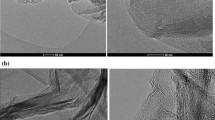Abstract
Amorphous conducting carbon films deposited over quartz substrates were analysed using X-ray diffraction and AFM technique. X-ray diffraction data reveal disorder and roughness in the plane of graphene sheet as compared to that of graphite. This roughness increases with decrease in preparation temperature. The AFM data shows surface roughness of carbon films depending on preparation temperatures. The surface roughness increases with decrease in preparation temperature. Also some nucleating islands were seen on the samples prepared at 900°C, which are not present on the films prepared at 700°C. Detailed analysis of these islands reveals distorted graphitic lattice arrangement. So we believe these islands to be nucleating graphitic. Power spectrum density (PSD) analysis of the carbon surface indicates a transition from the nonlinear growth mode to linear surface-diffusion dominated growth mode resulting in a relatively smoother surface as one moves from low preparation temperature to high preparation temperature. The amorphous carbon films deposited over a rough quartz substrate reveal nucleating diamond like structures. The density of these nucleating diamond like structures was found to be independent of substrate temperature (700–900° C).
Similar content being viewed by others
References
Amar J G, Lam P M and Family F 1993Phys. Rev. E47 3242
Bachtold A, Hadley P, Nakanishi T and Dekker C 2001Science 294 1317
Barabasi A L and Stanley H E 1995Fractal concepts in surface growth (Cambridge: Cambridge University Press)
Berry M V and Hannay J H 1978Nature 273 573
Casiraghi T C, Ferrari A C and Robertson J 2005Diamond Relat. Mater. 14 913
Chhowalla M, Yin Y, Amaratunga G A J, Mckenzie D R and Frauenheim T 1996Appl. Phys. Lett. 69 2344
Dimigen H, Hubsch H and Memming R 1997Appl. Phys. Lett. 50 1056
Family F and Vicsek T 1985J. Phys. A18 L75
Feder J 1988Fractals (New York: Plenum) Ch. 14
Franklin R E 1950Acta Crystallogr. 3 107
Freidmann T A, Sullivan J P, Knapp J A, Talland D R, Follstaedt D M, Medlin D L and Mirkarimi P B 1997Appl. Phys. Lett. 71 3820
Hembacher S, Giessibl F J, Mannhart J and Quate C F 2003Proc. Nat. Acad. Sci. 100 12542
Javey A, Guo J, Farmer D B, Wang Q, Wang D, Gordon R G, Lundstrom M and Dai H 2004Nanoletters 4 447
Lu T M, Yang H N and Wang G C 1995 inFractal aspects of materials (eds) F Familyet al, MRS symposia proceedings No. 367 (Pittsburgh: Materials Research Society) p. 283
Merkulov V I, Lowndes D H and Baylor L R 1999Appl. Phys. Lett. 75 1228
Obraztsov A N, Volkov A P and Pavlovsky I 2000Diamond Relat. Mater. 9 1190
Orwa J O, Andrienko I, Peng J L, Prawer S, Zhang Y B and Lau S P 2004J. Appl. Phys. 96 6286
Racine B, Ferrari A C, Morrison N A, Hutchings I, Milne W I and Robertson J 2001J. Appl. Phys. 90 5002
Ruland W 1968 inChemistry and physics of carbon (ed.) P L Walker Jr (New York: Marcel Dekker)Vol. 4, pp 1–84
Rusop M, Mominuzzaman S M, Soga T and Jimbo T 2004Diamond Relat. Mater. 13 2180
Sayeed Ahmed 1998Structural and electrical properties of amorphous conducting carbon films, Ph.D. thesis, Indian Institute of Science, Bangalore
Sayles R S and Thomas T R 1978Nature 271 431
Subramanyam S V 1996Indian J. Pure & Appl. Phys. 34 595
Subramanyam S V, Sayeed A, Meenakshi V, Bhattacharya S, Cholli A and Tripathi S 1997J. Appl. Phys. 81 2907
Umehara Y, Murai S, Koide Y and Murakami M 2002Diamond Relat. Mater. 11 1429
Voss R F 1985 inScaling phenomena in disordered systems (eds) R Pynn and A Skejeltorp (New York: Plenum) pp 1–11
Wolf D E and Villain J 1990Europhys. Lett. 13 389
Author information
Authors and Affiliations
Corresponding author
Rights and permissions
About this article
Cite this article
Vishwakarma, P.N., Prasad, V., Subramanyam, S.V. et al. Structural morphology of amorphous conducting carbon film. Bull Mater Sci 28, 609–615 (2005). https://doi.org/10.1007/BF02706351
Received:
Issue Date:
DOI: https://doi.org/10.1007/BF02706351




